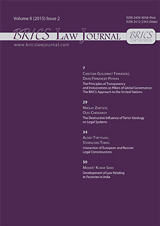
Academic peer-reviewed journal “BRICS Law Journal”
BRICS is an intergovernmental organization comprising Brazil, Russia, India, China, South Africa, Egypt, Ethiopia, Iran, and the United Arab Emirates. Originally established to highlight investment opportunities, the group is now assuming a greater geopolitical role aimed at institutional reforms that will rebalance global power. In 2024, BRICS embarks on a ‘historic’ expansion’ by welcoming Egypt, Ethiopia, Iran, and the United Arab Emirates as new member countries, making the group even more powerful politically and economically. All countries adhere to the principles of inclusive macroeconomic and social policies while focusing on responsible national growth strategies. The BRICS group positions itself as more than just an economic forum through its commitment to the creation of a more representative, fairer international order and a reinvigorated and reformed multilateral system.
The BRICS Law Journal serves as a platform for comparative research and legal development not only in and among the BRICS countries themselves but, more importantly, also between the BRICS countries and other countries across the globe. Additionally, the Journal provides an open forum for legal scholars and practitioners to reflect on issues of international significance that are relevant to the BRICS countries. Prospective authors who are involved in legal research, legal writing, and legal development associated with these subjects are, therefore, the main source of potential contributions for publications in the Journal.
Presentation (.ppt)
Current issue
GUEST EDITOR NOTE
ARTICLE
ARTICLE IN RUSSIAN
CONFERENCE REVIEWS
Announcements
2023-08-17
Event digest
The BRICS Law Journal contributes to international discussion on research journals
On 8 August, the BRICS Law Journal hosted a webinar dedicated to the development and promotion of research journals. Editors, researchers, and authors from countries across the world came together to share their experience and knowledge on how to improve the quality, significance, and credibility of articles for publication, and thus the success of research journals.
During the event, guest speakers delivered presentations on the role of international journals, journal policies, and editorial processes. Particularly insightful were the topics on how to help authors promote their papers and how to establish effective collaboration between the editorial board, reviewers, and authors.
The guest speakers, each with extensive experience in the field of research journals, included Elena Gladun, the Editor-in-Chief of BRICS Law Journal; Niteesh Kumar Upadhyay representing Galgotias University; Elizaveta Gromova representing the International Journal of Law in Changing World; Daniel Brantes Ferreira from the Brazilian Center for Mediation and Arbitration; and Aleksandra Zorina representing the University of Tyumen.
It was especially gratifying to see that the webinar attracted not only representatives from the BRICS countries but also participants from other regions of the world, including the United States of America. This demonstrates that research journals attract attention and engage the interest of readers from different backgrounds yet with common interests, allowing for fruitful discussions and the exchange of ideas and knowledge.
The participants found the webinar to be highly informative and so useful that they decided to meet quarterly, organize more thematic webinars, and provide authors with mailings on major journal news.
The BRICS Law Journal thanks all webinar participants for their productive work!
We look forward to taking part in similar events in the future and to seeing our friends, authors, and colleagues again.
The BRICS Law Journal is more than just a research journal - it is a community of thoughtful people who are always ready to assist each other in research and development.
| More Announcements... |







































